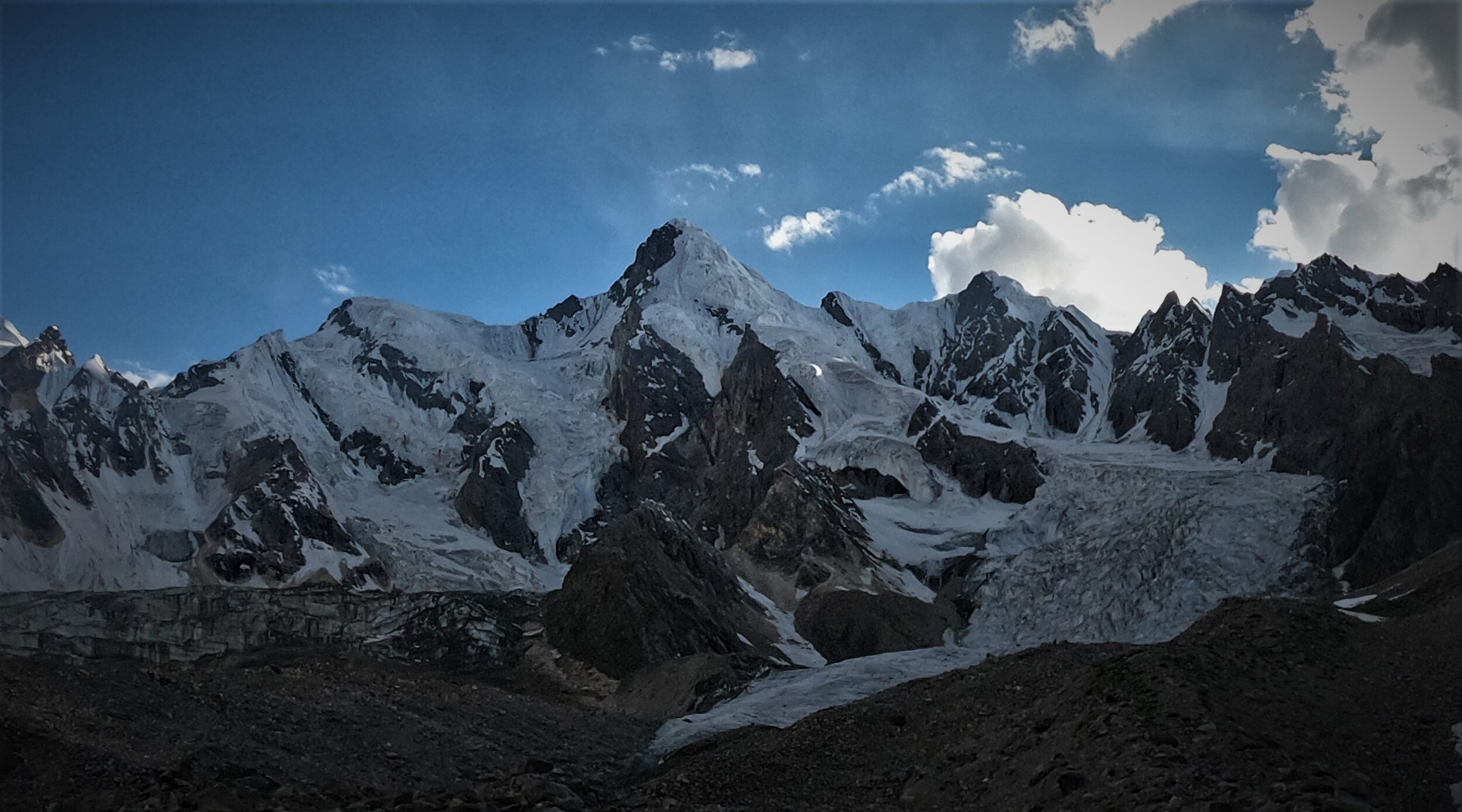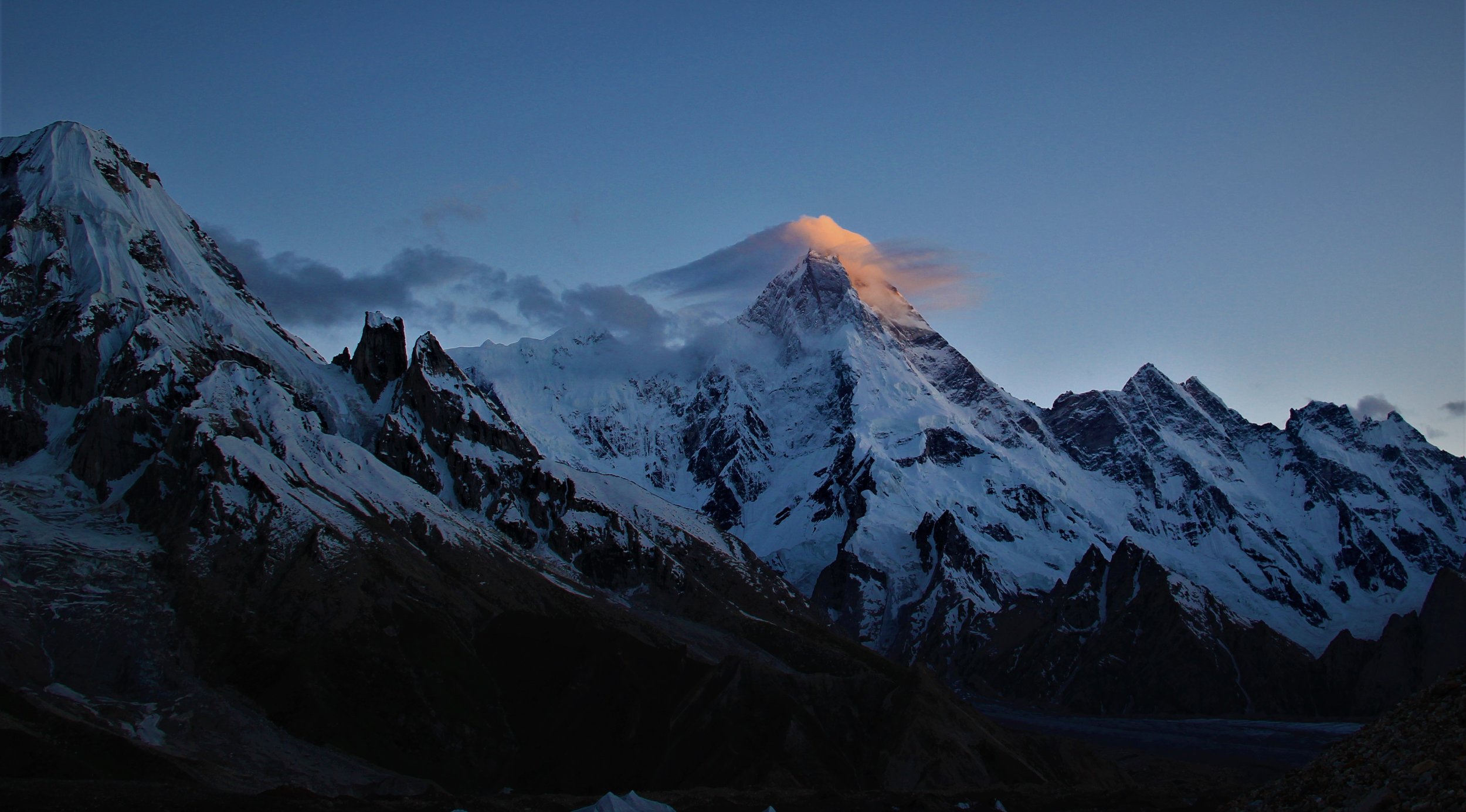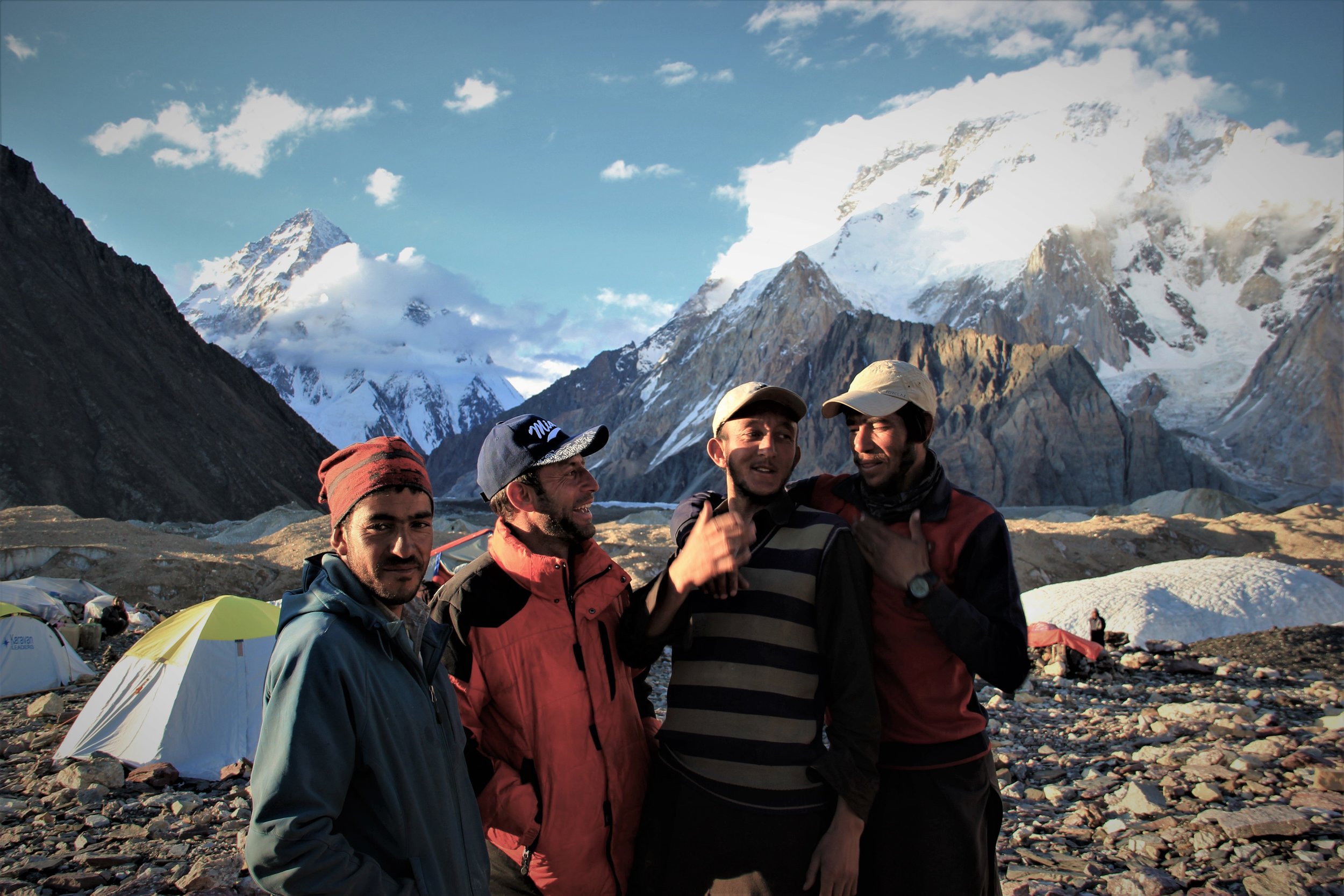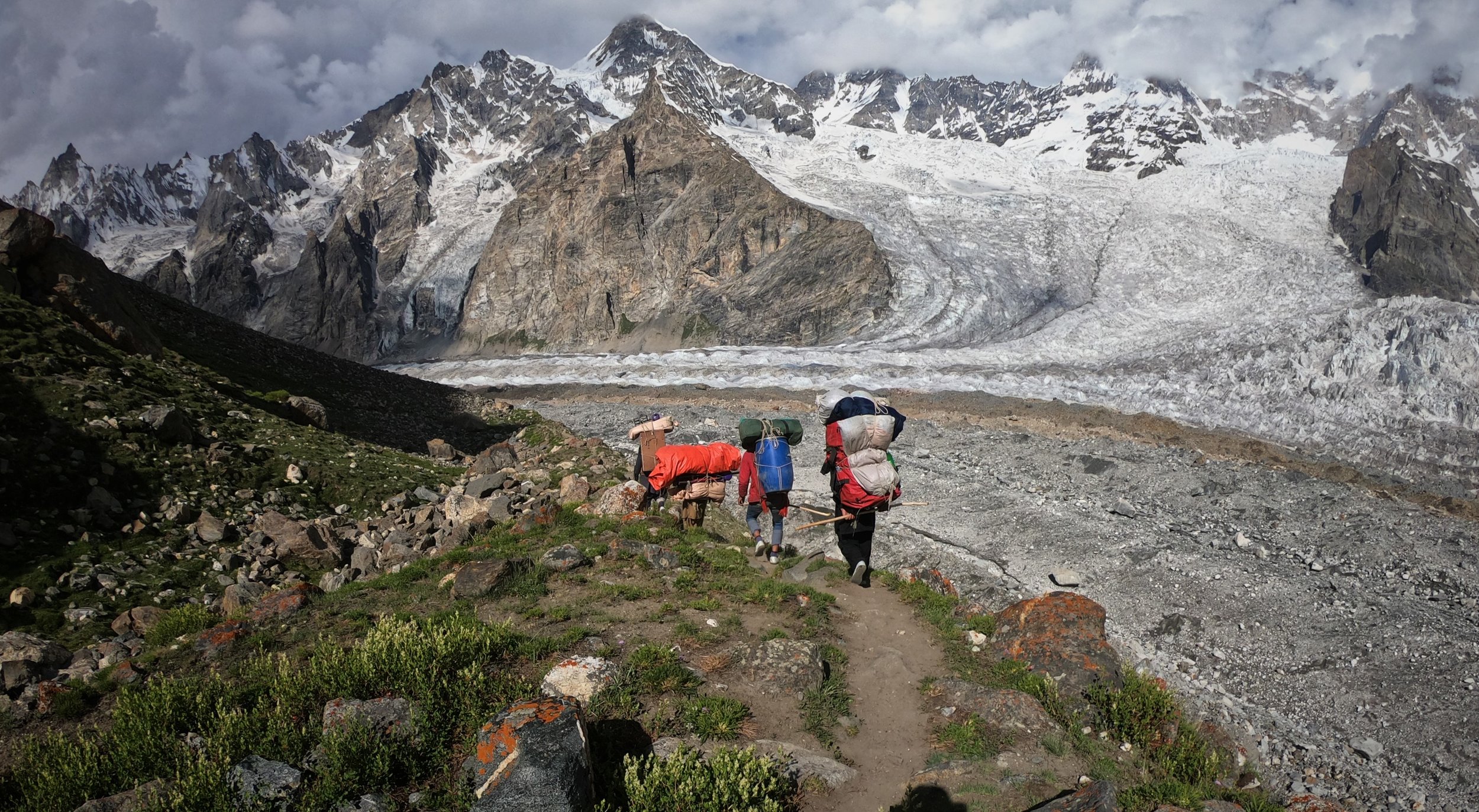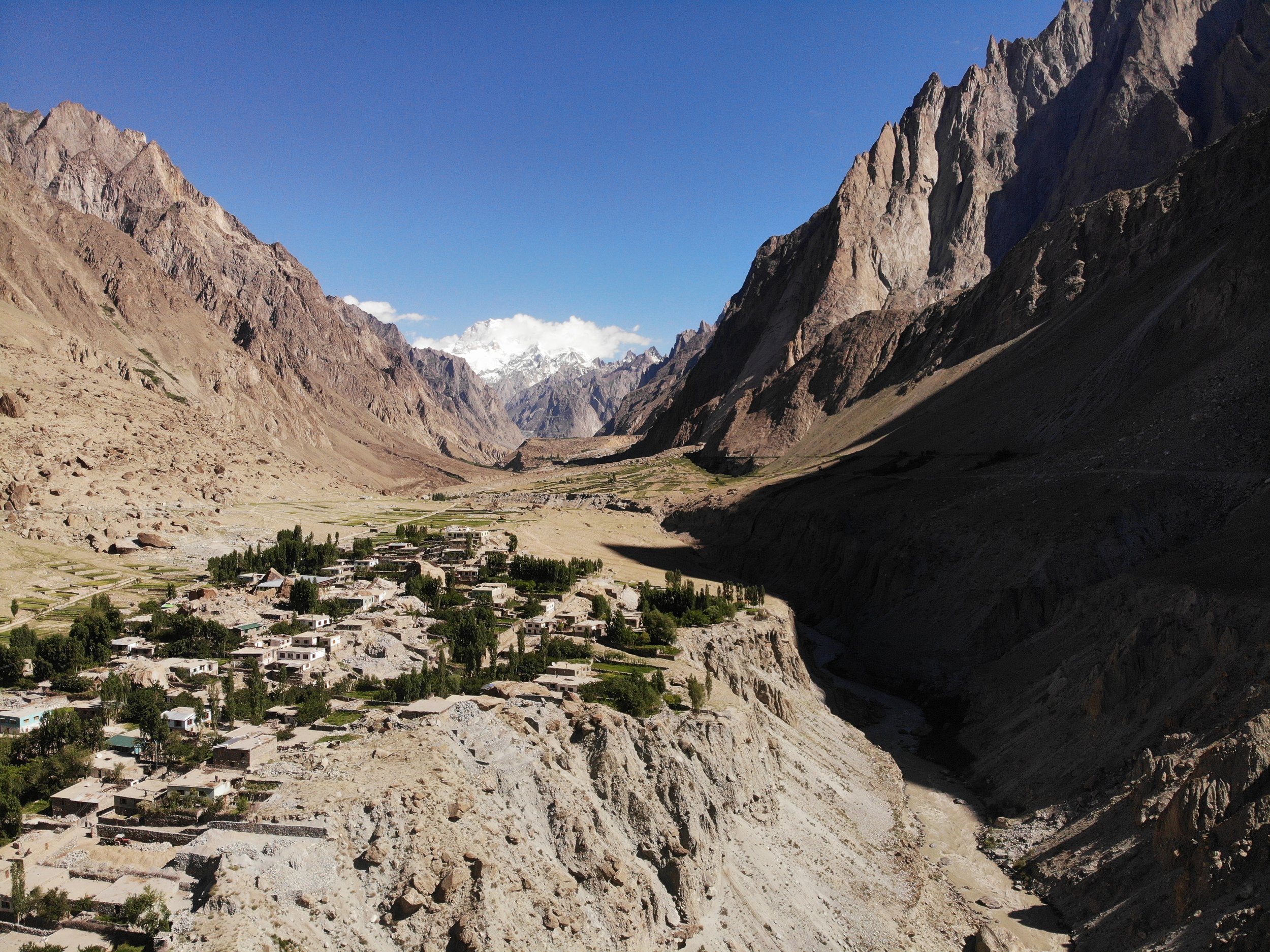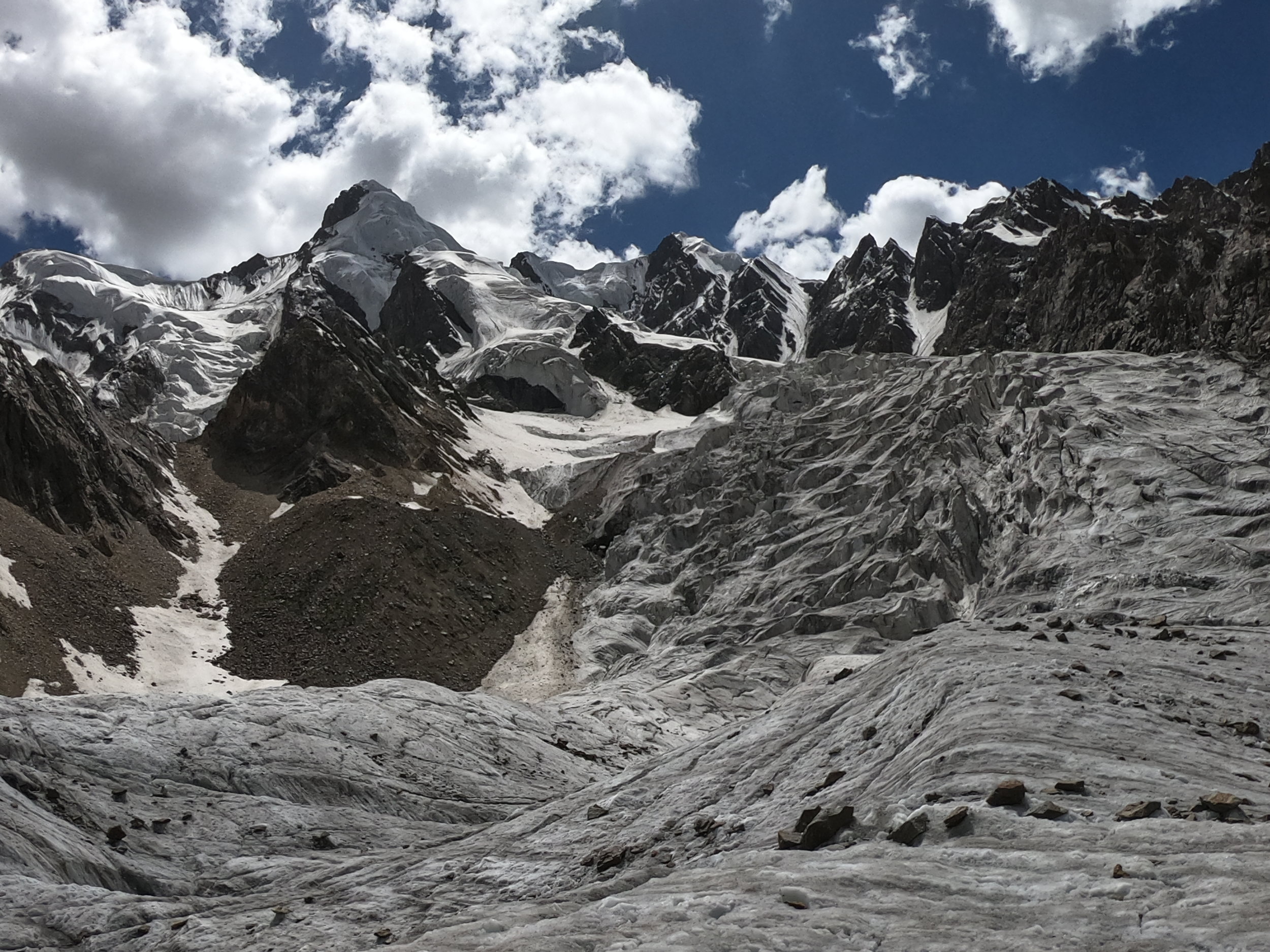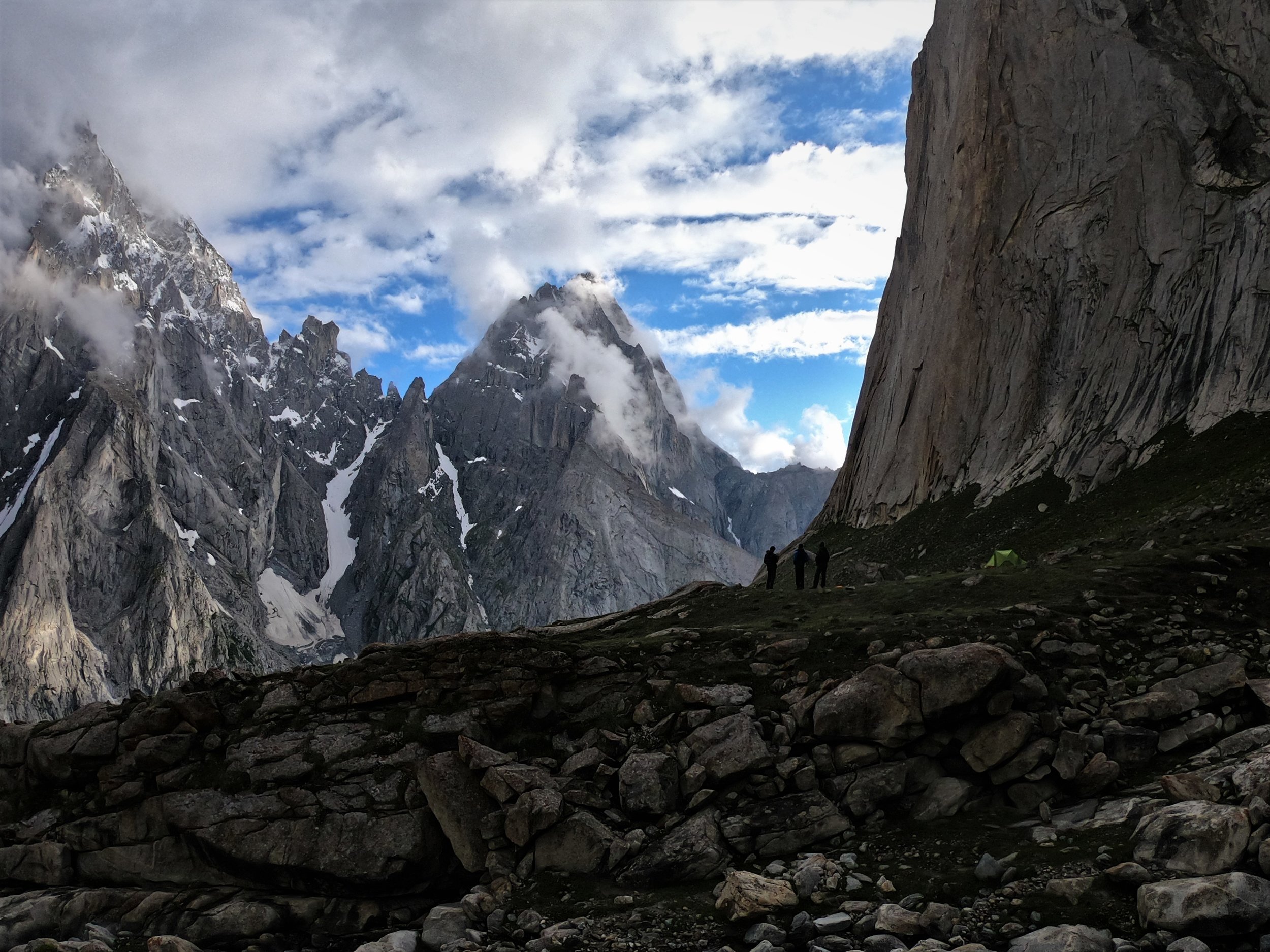“If you really want to climb, don’t go to the Himalaya”. Legendary mountaineer and explorer Bill Tilman said that 80 years ago and it still holds true today - the Himalayan/Karakorum chain and mountains throughout Central Asia are far more for the “cross country mountaineer” as Sir Edmund Hillary called Eric Shipton , Tilmans partner on so many adventures. The Himalayas – and Karakorum range especially is largely about exploration , route finding , carrying heavy packs, river crossings and trying to find out if the country you are traversing has any relationship at all to the published maps or Google earth sat images you have. Yes it is possible to go “just” climbing on generic expeditions to some of the few mountains that have actually been climbed and have routes set up on them but for everyone of them there are literally dozens of 6000m peaks, hundreds of 5000m ones and even the odd 7000m peak un-climbed and valleys and villages almost as remote as in the days of Tilman.
Just “climbing’ is merely a part of mountaineering for me - that is the sport side but the real interest is exploring and there the mountains of Central Asia are still as far as actually setting feet to the ground largely untrod by those who live outside them (and sometimes even by those who live there) and mountains untouched.
Our trip was in 2 parts – the firstly in fact very Generic – trekking up the Baltoro , to Concordia - visiting the memorial at K2 than heading over the Vigne glacier , up the Gondogoro Pass into Hushe valley. There were several reasons for doing this – the main one for me was to film the Balti mountain workers and especially the porters in action over what is perhaps the most difficult regular commercial trek in the World. The trek proved even more interesting in this regard than I thought and that was entirely due to the tremendous efforts of those same Balti mountain workers and through out one wondered on their incredible strength, endurance and ever sure feet in the very tough conditions and not the least in the frugal existence they accept with smiles. The Gondogoro pass seemed like a rite of passage even for the porters and those that had crossed the most with the heaviest loads were looked up to by the others as leaders of the pack.
Apart from the spectacular scenery of trekking right thru the midst of the greatest mountain range on Earth surrounded at one stage by four 8000m peaks including the mountain of mountains K2 not to mention at least a dozen 7000m peaks the trek was training for our small group in advance of going into the unknown. Trekking over the 5650m Gondogoro would be good acclimatization for attempting some 6000m peaks. Kadin , Elliot , Dairmuid and myself had our sights set on trying this in a valley near Kandi in the Hushe valley. Although this area was by no means un-visited I can honestly say we had no idea where the peaks were and the maps are totally inaccurate just giving a rough outline of what could be there and even previous reports being totally unclear of what was actually there.
So we found ourselves at base camp in a glacial valley called Bondit attempting a beautiful white pyramid called locally Bondit peak of about 6000m. Our 2 youngsters, Kadin and Elliot were down ill , they had been on and off sick ever since arriving in Pakistan 3 weeks before – Dairmuid and myself had both suffered as well and I have never been on such a sickly trip before , but we had never been bed ridden. Seeing the mountain we optimistically attacked the ice fall with full loads hoping to establish a route up to camp 1 at 5000m plus. Initially the going was great but than , well huge chasms opened up in all directions stymieing us completely . Only later when we saw the ice fall from above did we fully realize the impossibility of climbing the Bondit glacier via the icefall so late in the year. We retreated with some difficulty and returned to camp somewhat chagrined. The next day more sagely with out loads, we made a reconnaissance on another potential route which seemed to be more viable and set up camp 2 days later with help of a fresh and now recovered Kadin.
My previous experiences around Nanga Prabat and in the Karakorum is that its all pretty straight forward till around 5000m give or take – that’s if you discount the rivers. There is nothing like the rivers and even small streams that are found here – we are talking several orders of violence over anything else I have ever seen – I read somewhere that blocks as big as apartment buildings are been thrown down them – this is surely an exaggeration but blocks as big as trucks wouldn't be! If the rapids could be survived for a few seconds you would be crushed to pulp by all the blocks coming down. Than around the 5000m mark it all turns to custard and from than on it seems the sole wish of the mountain is to exterminate those who tread on it. Bondit peak was no different. As soon as we left camp 1 at roughly 5000m and traversed some ice cliffs over huge drop offs before climbing up a moderately angled ice climb the action began. First let me explain what moderate angle in the Karakorum means. Even further back in time than Tilman was Tom Longstaff, one of the truly incredible Victorian era English explorers and mountaineers . He wrote – "in the Alps slopes are usually easier than the look – in the Caucasus mountains they are as difficult as they look but in the Himalayas they are much steeper than they look". The same holds true today – there is some optical illusion operating in these mountains and you look at an easy slope say 30 – 40 degrees and when you get on it its like 60 plus. There was one small consolation on Bondit – the only one we got in 2 weeks - after scrapping of loose snow a couple of good belts of the ice axe would give excellent plastic ice to climb on – something I needed considering the short slide and than 1000 foot plus vertical drop over a huge rock face if things came unhinged.
Well we barely got onto the slope when blocks of ice came hurling past – a shot across the bows in nautical terms I called it or a small warning of the malevolence that could be expected by any any attempt to climb on - and so it was. Further up we tried to climb – or at least Kadin did a ice couloir (gully) covered in extremely dodgy snow under belay – it was scary just to look at not to mention tottering seracs (ice cliffs) directly above us . We gave up on that and didn't even attempt another couloir that may have been possible but again it was covered in dodgy snow. Both Kadin and Dairmuid were for trying the ice cliffs directly behind us – Dairmuid didn’t think they were even 50 degrees – my own estimation – publicly was 60 degrees plus - privately 70 -80 degrees factoring in that it's always way steeper than it looks. Perhaps with no loads we could get up ok but it was no route for an expedition where we had to set up further camps – even if we had 3-400 meters of fixed rope to put up which we didn’t.
Diarmuid and I stayed at camp one the night were we woken up frequently to rain and crashing seracs. The rain began a whole change in weather and a vast deterioration in mountain conditions. It rained for 2 days and havoc was been unleashed on the mountain while we returned and rested in BC.
We gave up on Bondit!! During the rest days we had all explored some other possibilities on smaller surrounding mountains and one un-named peak of about 5600m west of Bondit looked interesting and Diarmuid and Kadin had found a rocky route to access it. We went and retrieved our gear from camp 1 and started the shift to the second mountain – not without incident as Diarmuid almost got clobbered by falling rock.
Dairmuid went down ill so Elliot , Kadin and I went up , set up fixed line over a rock cliff – and than we ventured up onto the unknown glacier. looking for a good spot to place camp one although Elliot decided to turn before we actually got on the ice. There was plenty of evidence of rockfall from the huge almost vertical rock cliff's to the right of us so we kept a very good distance from them choosing the medial moraine rocks down the center of the wide glacial plateau we found ourselves upon. It’s often said if you respect the mountains they will respect you. From what I've seen, if you respect the Karakorum they will hurl ice and boulders all over you – least of all they seem to have no respect at all for Sir Issac Newton and the laws of gravity. In theory rocks coming off a cliff go straight down – but not here- they fly horizontally out at a tremendous speed going a tremendous distance not at all In the calculations of the odd alpine enthusiast that visit's them. Here I’m not even mentioning the amount that is flying , not dozens , or even hundreds but thousands of blocks exploding sideways out of a cliff . Yes this was no warning shot over the bows – this was a full broadside. I was someways in front therefore much closer to the action and dove immediately under the largest, nearest bolder and curled myself into the fetal position . Kadin behind started a mad dash backwards. Fortunately the falling rock was a few minutes in our future and although stuff was coming close I think nothing landed next to me although the 300 odd meters in front was totally annihilated and huge blocks went deep onto and into the glacier. After the shrapnel died out I stood up and started walking back to Kadin - we were both shaking our heads in disbelief when a second broadside was unleashed, Back I was,under another boulder just hiding and waiting . This time when the shrapnel cleared I think we had both had enough. It's sobering indeed to know the safe route you were on now lay under thousands of tons of dirty rock with the whiteness of ice no longer to be seen. Even worse as far as any prospect of climbing this mountain when I spied that the prominent coulior high up we had planned to climb had a vee shape of rocks at the bottom of it signifying avalanche rock. From the distance it still looked insignificant but realistically it was a death trap for anyone in it that narrow gully.
We went back to where we had dropped off the gear with Elliot and I must admit , I was all for quitting than and there - Karakorum shell shock had set in. There was nowhere safe or even moderately safe up high– perhaps earlier season was better but it was just a matter of time hanging around here before we were squished. These mountains were tottering mass’s whose even tiniest stone defied the laws of gravity by not falling. Compared to these even the worst weetbix rock we talk of in New Zealand was like reinforced concrete.
We descended in falling snow and sleet with Kadin preserving the faint hope that there may still be another way.The weather packed up for another couple of days giving us time to think about it all and rebuild shattered nerves.
Shell shock - first noted in World War one as the psychological breakdown of soldiers exposed to constant enemy fire seems to be a feature of the Karakorum - I’ve seen it in the glazed eyes of most who have spent a week or more higher on the slopes - the constant exposure to danger. The best way to over come this is to adopt the “if God will’s” attitude of the local’s. “In Shah Allah”. Arabic of “if God will’s” is the most common general expression in the Islamic world and certainly no more fitting than once you get up to these mountain heights around the Karakorum massif and K2 - or for that matter if you take a K2 bus on a highway much lower down. During our next 2 days at base whilst I sat down in base camp interviewing Ibrahim a crack drew both of our attention’s upwards to the slope adjacent to us. An enormous block , the size of a car was tumbling down with it’s associated shrapnel. I looked at the slope above our Camp - it was almost identical and covered in large blocks - certainly it didn’t seem steep enough to launch any but as I looked around the campsite I realized it was covered in those same blocks from those same slopes- this wasn’t moraine debris from below as I had thought! - this was rocks from above - “In Shah Allah” as I went I lay in the tent that night. In the morning I looked up to our former Camp 1 on Bondit and the route we has climbed on. An enormous serac from far above came tumbling down and shattered into a millions glassy shards all over that same route for spreading itself for acres - “In Shah Allah”. Yes anyone wanting to cure themselves of atheism should come and spend a couple of weeks here!!
After a day at Base camp and getting bored I did a solo hike to attempt a climb of about 5200m at the base of the valley. I left to late in the day to have any real chance of success but the story was the same. Moving light and fast with no pack or anything , not even a water bottle, I climbed a steep water gully to a small glacier than up towards the rocky summit which looked fairly possible .At about 5000 meters though the terrain started getting much steeper and the again incredibly loose. Time had run out on me and I had to turn back but that was a relief more than anything else although at one stage I had to walk under a massive tower of loose blocks that I had inadvertently walked under on the way in. Alternatives looked even worse and it was an In Shah Allah attitude that I scrambled as quickly as I could under this tower as high but much wider than a 20 story building so perforated with airy holes that one could see clean through it in places and it defied my imagination as to how it actually managed to “float” there. Elliot had previously attempted the same climb and came back with the same story and results.
2 days of rest left me rather more positive of one last attempt on our unknown peak - maybe a mad dash to the top if possible. The others kitted up just after breakfast to leave but for some reason I just couldn’t get going. Finally after lunch we all started dragging ourselves towards camp 1 but after climbing the steep scree to the small col above base camp I sat down totally exhausted. It was physical exhaustion - 4 weeks on the go with almost no rest had caught up with me and now it was hard to move even. The other 3 waited expectantly so after 45 minutes I dragged myself on but was totally empty just making it into the tent that was pitched already and crashing out. Diarmuid’s alarm went at 5am and although I had had a bad sleep, curiously as the human body does I felt fairly recovered and almost though of joining Kadin and him on attempting to get higher up. I was still to weak though and rested up with Elliot who had not got any sleep too busy listening to crashing rock and ice all night - he was still at shell shock stage. From far below we watched Dairmuid and Kadin spend an impossibly long time climbing what appeared to be a moderate ice wall (the original couloir we had looked to climbing was now liberally covered with avalanche debris after the recent bad weather)- they disappeared for awhile than started retreating back to camp where we meet them early afternoon with familiar story’s, crevasse’s had blocked the route , Kadin had fallen in one and what looked like a moderate ice slope Diarmuid claimed was almost vertical??
The climbing was over - we returned to Kandi and headed East to the more well defined Nangma valley with its amazing collection of awesome rock towers. It is a geological wonder that the Nangma side has rock as hard and finely defined as the Kandi glacier valley to the west was no more than pile’s of loose ragged boulders. The river separated the opposite sides cleanly and evenly split them into their real natures and this difference was evident all the way down the river valley.
For three days we trekked in Nangma - just making the most of the last of our time in the Hushe/Kandi area. Whilst in the hills we meet Nazir, a school teacher who was chasing around a yak bull trying to get him down to the village far below. Maybe I was looking old and tired because he kept on insisting to carry my pack (which was not heavy anyway) - and I had to rebuff him several times - I mean honor and pride would have never let me do that no mater how tired! Just 2 days later though whilst crossing a small river (or large stream) things got tricky. Crossing a stream in these parts is kinda like traversing a steep bit of loose rock or glassy ice in the mountains - first you look down to see whats going to happen if you don’t make it and it’s usually quite a fall before you hit the surging current. It was a couple of meters jump - but almost a meter up as well and the consequences of miss footing didn’t look very positive. We had a local guide with us - a sure footed Balti who promptly jumped across - than almost went over in the boulder into the water and fell back again and than sideways - I thought he was going swimming for sure but at the last moment he saved himself. I went to jump - it was going to be close and I dared not hesitate. I leaped - halfway across the guides hand shot out and I grabbed it - pride and honor had gone - now it was survival!






























